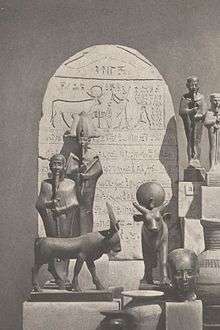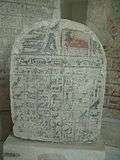Shoshenq V
| Shoshenq V | |||||||||||||||||||||||||||||||||||||||||||||||||||||||||||||||||||||||||||||||||||||||||||||||||
|---|---|---|---|---|---|---|---|---|---|---|---|---|---|---|---|---|---|---|---|---|---|---|---|---|---|---|---|---|---|---|---|---|---|---|---|---|---|---|---|---|---|---|---|---|---|---|---|---|---|---|---|---|---|---|---|---|---|---|---|---|---|---|---|---|---|---|---|---|---|---|---|---|---|---|---|---|---|---|---|---|---|---|---|---|---|---|---|---|---|---|---|---|---|---|---|---|---|
 In the background, Shoshenq V standing in front of an Apis bull on a stela of his Year 37. | |||||||||||||||||||||||||||||||||||||||||||||||||||||||||||||||||||||||||||||||||||||||||||||||||
| Pharaoh | |||||||||||||||||||||||||||||||||||||||||||||||||||||||||||||||||||||||||||||||||||||||||||||||||
| Reign | c. 767–730 BC (22nd Dynasty) | ||||||||||||||||||||||||||||||||||||||||||||||||||||||||||||||||||||||||||||||||||||||||||||||||
| Predecessor | Pami | ||||||||||||||||||||||||||||||||||||||||||||||||||||||||||||||||||||||||||||||||||||||||||||||||
| Successor | Osorkon IV or Pedubast II | ||||||||||||||||||||||||||||||||||||||||||||||||||||||||||||||||||||||||||||||||||||||||||||||||
| |||||||||||||||||||||||||||||||||||||||||||||||||||||||||||||||||||||||||||||||||||||||||||||||||
| Consort | Tadibast III? | ||||||||||||||||||||||||||||||||||||||||||||||||||||||||||||||||||||||||||||||||||||||||||||||||
| Children | Osorkon IV? or Pedubast II? | ||||||||||||||||||||||||||||||||||||||||||||||||||||||||||||||||||||||||||||||||||||||||||||||||
| Father | Pami | ||||||||||||||||||||||||||||||||||||||||||||||||||||||||||||||||||||||||||||||||||||||||||||||||
| Died | c. 730 BC | ||||||||||||||||||||||||||||||||||||||||||||||||||||||||||||||||||||||||||||||||||||||||||||||||
Aakheperre Shoshenq V was a pharaoh of the late 22nd Dynasty.
Reign
Overview
According to a Serapeum stela dated to his Year 11, Shoshenq was son and successor of Pami.[3] He ascended to the throne in ca. 767 BC[4] and, despite little information about his life, he is well attested by several monuments, dated and not. However, the provenance of such findings is limited to the Eastern Nile Delta – in fact the territory under his authority – and noticeably, he is completely unrecorded in Thebes.[5] Furthermore, it looks that during Shoshenq's reign his lordship above the city of Memphis and the westernmost part of his realms phased out for the benefit of the Libyan chiefs of the Western Delta such as Osorkon C and, ultimately, Tefnakht of Sais.[6][7] At the end of his long reign – most likely lasting 38 years – Shoshenq ruled little more than the districts of Tanis and Bubastis.[8]
Before the discovery of the proper Shoshenq IV, Shoshenq V was often referred to with the "IV" numeral (for example:[9][10]).
Attestations

Shoshenq's Year 11 is recorded at Memphis, commemorating the death, burial and replacement of the Apis bull which was installed in the Year 2 of Pami. Shoshenq is also attested in his years 8,[11] 15 (or 17),[12] 19[13] and 30[14] by donation stelae of different Great Chiefs of the Libu, named Niumateped, Titaru, Ker, and Rudamun respectively. Then, his name appears again on a stela from Atfih, dedicated to the goddess Hathor in Shoshenq's Year 22.[10][15]
At Tanis, he ordered a temple for the Theban Triad, in particular for the god Khonsu. Probably in his Year 30, he also celebrated his Sed festival by adding a jubilee chapel to the aforementioned temple.[16][17][18] These buildings were later dismantled and a sacred lake was made in their place. Yet, from the remains of the buildings, it is known that Shoshenq celebrated the festival by adopting brand-new Horus, Nebty and Golden Horus names, and by adding complements to his Throne and personal names, in sharp contrast with the plain and simple titulary used in most of his monuments (the one reported in the box[19]) which was possibly a form of archaisation. Undated monuments of Shoshenq V were unearthed at Tell el-Yahudiyeh.[20]
In Year 37 of Shoshenq, the Apis bull installed in his Year 11 died and was buried. The event is commemorated on several Serapeum stelae, the most famous among these being the Stela of Pasenhor, which also provided a valuable genealogy of the early 22nd Dynasty and its Libyan origin.[3][17] This bull eventually outlived Shoshenq, dying in Year 5 of pharaoh Bakenranef of the 24th Dynasty.[21]
Shoshenq V's highest Year date is an anonymous Year 38 donation stela from Buto issued by Tefnakht (here boasting several titles, but not yet a pharaoh) which can only belong to his reign since Tefnakht was a late contemporary of this king. This stela, which reads simply as "Regnal Year 38 under the Majesty of the King of Upper and Lower Egypt, Lord of the Two Lands, [BLANK], Son of Re, [BLANK]," may reflect the growing power of Tefnakht in the Western Delta at the expense of Shoshenq V whose name is omitted from the document. The same argument can be applied to a similar stela, again issued by Tefnakht but in an anonymous Year 36 which again can only belong to Shoshenq's reign.[22]
End and succession
Shoshenq V died probably in 730 BC. Besides his father Pami, his family relationships are not entirely clear, but it is often assumed that his successor was Osorkon IV who also may have been his son.[18] It is known that Osorkon's mother was queen Tadibast III; thus, she was possibly Shoshenq's queen.[23] However, this reconstruction is complicated by the presence of the poorly known pharaoh Pedubast II who is sometimes placed as Shoshenq's successor.[24]
References
- ↑ Clayton, Peter (1994). Chronicle of the Pharaohs. Thames & Hudson Ltd., p. 185
- ↑ Kitchen, § 309
- 1 2 Kitchen, §§ 84-85
- ↑ Kitchen, revised Table 3
- ↑ Kitchen, § 103
- ↑ Kitchen, §§ 311; 316
- ↑ Edwards, pp. 571-572
- ↑ Kitchen, § 92
- ↑ Gardiner, Alan (1961). Egypt of the Pharaohs: an introduction. Oxford University Press., p. 326
- 1 2 Peet, T.E. (1920). "A Stela of the Reign of Sheshonk IV". Journal of Egyptian Archaeology. 6: 56–57.
- ↑ Spiegelberg, Wilhelm (1920). "Neue Schenkungsstelen uber Landstiftungen an Tempel". Zeitschrift für Ägyptische Sprache und Altertumskunde. 56., pp 57–58
- ↑ Brooklyn Museum 67.119
- ↑ Müller, Wilhelm Max (1906). Egyptological Researches, vol. I. Carnegie Institution of Washington., pl. 88
- ↑ Berlandini, Jocelyne (1978). "Une stèlae de donation du dynaste libyen Roudamon". BIFAO. 78: 147–153.
- ↑ Kitchen, §§ 310-311; 521
- ↑ Kitchen, §§ 315; 396
- 1 2 Edwards, p. 569
- 1 2 Grimal, Nicolas (1992). A History of Ancient Egypt. Oxford: Blackwell Books. p. 512. ISBN 9780631174721., pp. 330-331
- ↑ von Beckerath, Jürgen (1999). Handbuch der Ägyptischen Königsnamen. Mainz. ISBN 3 8053 2591 6., pp. 190-191
- ↑ Kitchen, §§ 309; 315
- ↑ Kitchen, § 147
- ↑ Kitchen, §§ 84; 112; 316
- ↑ Berlandini, Jocelyne (1979). "Petits monuments royaux de la XXIe à la XXVe dynastie". Hommages à la mémoire de Serge Sauneron, vol. I, Egypte pharaonique. Cairo, Imprimerie de l'Institut d'Archeologie Orientale. pp. 89–114., pp. 100-101
- ↑ von Beckerath, Jürgen (1997). Chronologie des pharaonischen Ägyptens. Mainz am Rhein: Münchner Ägyptologische Studien 46., p. 99
Bibliography
| Wikimedia Commons has media related to Shoshenq V. |
- Edwards, I.E.S. (1982). "Egypt: from the Twenty-second to the Twenty-fourth Dynasty". In Edwards, I.E.S. The Cambridge Ancient History (2nd ed.), vol. III, part 1. Cambridge University Press. pp. 534–580. ISBN 0 521 22496 9.
- Kitchen, Kenneth A. (1996). The Third Intermediate Period in Egypt (1100–650 BC). Warminster: Aris & Phillips Limited. p. 608. ISBN 0-85668-298-5.
| Preceded by Pami |
Pharaoh of Egypt 767 – 730 BC Twenty-second dynasty of Egypt |
Succeeded by Osorkon IV or Pedubast II |
